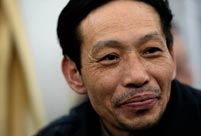 Int'l Snow Sculpture Art Expo in Harbin
Int'l Snow Sculpture Art Expo in Harbin Sichuan money wall for dividend payment
Sichuan money wall for dividend payment Li Na crashes Belinda Bencic in 2nd round at Australian Open
Li Na crashes Belinda Bencic in 2nd round at Australian Open
 Shocking moments when PLA's weapons open fire
Shocking moments when PLA's weapons open fire Famous Lanzhou beef noodles
Famous Lanzhou beef noodles Armed Police hold anti-terrorism drill in SE China's Xiamen
Armed Police hold anti-terrorism drill in SE China's Xiamen Harbin Int'l Ice and Snow Festival opens
Harbin Int'l Ice and Snow Festival opens 'Jin' named the word of the year by cross-strait netizens
'Jin' named the word of the year by cross-strait netizens Chinese scientific expedition goes to build new Antarctica station
Chinese scientific expedition goes to build new Antarctica station
BEIJING, Jan. 24 (Xinhuanet) --Walking out of prison in November last year, 40-year-old Tian Lei did not know how to continue a life outside, because since the age of 22, he had spent a good 18 years within the high walls.
"I felt a little disoriented walking on the street," said Tian, who had no household registry, no residence and no job. His parents divorced to form new families, and his old house was dismantled for relocation.
Four days later, Sunshine Halfway House, a community corrections center, accepted him, offering him free food, accommodation, and above all, skills training. There, Tian found home, halfway on the road back to society.
As a certified, professional community correction center, Sunshine Halfway House has been operating for five years, during which time it has provided necessary skills training for those who need it, besides temporary accommodation for people like Tian, putting more than two thousand people back into society.
"This is one difference between community corrections centers in Beijing and those in other places," said Liu Yong, a senior justice officer in Beijing's Chaoyang District.
Social correction started to attract the public's attention following the abolishment of education through labor, or the labor camps, at the Third Plenum of CPC's 18th Central Committee held in November 2013. The meeting has proposed a nationwide "improvement of the laws regarding crime correction."
Serving a sentence in the community
Community correction, a non-custodial sentence, has been in force in China for 10 years. In 2003, six provinces and municipalities including Beijing, started to pilot the new measures.
"Since 2003, more than 5,000 people have received community correction in Chaoyang," said Liu, adding that the number was increasing quickly. "In Chaoyang alone, more than 1,200 people serve community sentences each year," he said.
The singer Zang Tianshuo is a famous example. Zang was sentenced to six years in prison for affray in January 2010, but released on parole in February 2013. He was subjected to community service for 18 months and 20 days.
During this period, Zang's identity changed from "a prisoner" to "a person in community correction." He had to hand in routine reports on his recent acts and thoughts, ask for permission to travel to other cities, and participate in volunteer labor.
Social correction, or "serving a term outside prison," has its origin outside China. It has been regarded as a revolutionary innovation in the penal system, since it advocates that the goal of punishment should not be "retribution and intimidation" but "social protection through correcting criminals."
Compared with imprisonment, community correction has many advantages, such as saving resources and legal costs, facilitating crime correction, and maximizing protection for human right.
In this pilot program, different places are allowed to customize their own practices. Some even differ remarkably, for example the Beijing model and the Shanghai model.
In Shanghai, the local government buys the service from private social groups, and has them manage the daily operation of corrections centers. In Beijing, there is more participation from state organs. The local justice departments are in charge of community correction with assistance from prison police officers.
As the pilot program has developed, laws and stipulations have also matured. On Feb. 20, 2012, China's Supreme People's Court and Supreme People's Procuratorate jointly issued the "Measures for the Implementation of Community Correction." Half a month later, on Feb. 5, China's Criminal Law Amendment (8th Edition) formally validated social correction for the first time.
In the beginning, those who went through community correction were delinquent minors, and were mostly in urban neighborhood communities and rural towns. Later on, it expanded to cover those on public surveillance, probation, parole, non-custodial sentences, and those deprived of political rights.

 A 60-hour journey home
A 60-hour journey home Int'l Snow Sculpture Art Expo
Int'l Snow Sculpture Art Expo Highlights of China's air force
Highlights of China's air force Airline crew stage flashmob dance at Kunming airport
Airline crew stage flashmob dance at Kunming airport Top15 countries to retire to in 2014
Top15 countries to retire to in 2014 Hot supermodel's new photo album released
Hot supermodel's new photo album released Asia's heaviest box girder finishes 'rotation' in Wuhan
Asia's heaviest box girder finishes 'rotation' in Wuhan Completed facade of People's Daily new headquarters
Completed facade of People's Daily new headquarters Chinese-branded car passes North America standard safety test for the first time
Chinese-branded car passes North America standard safety test for the first time Li Na beats Bouchard to reach Australian final
Li Na beats Bouchard to reach Australian final  Explore the sources of PM 2.5
Explore the sources of PM 2.5 Highlights of Chinese airborne troops'exercises
Highlights of Chinese airborne troops'exercises  'Living in ice house' competition held in central China
'Living in ice house' competition held in central China  Chinese figure in Oscar nominations
Chinese figure in Oscar nominations  Top ten aerospace events in China 2013
Top ten aerospace events in China 2013Day|Week|Month